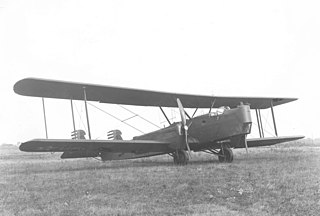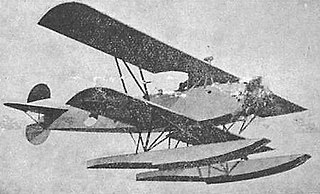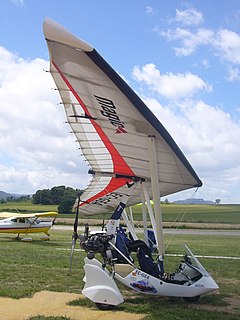
The General Aviation / Fokker XA-7 was a prototype attack aircraft ordered in December 1929, and first flown in January 1931 by Fokker and then General Aviation Corporation after it bought Fokker-America in 1930, and entered in a competition held by the United States Army. However, the Curtiss A-8 won the competition, and A-7 development was not continued.

The Huff-Daland XB-1 was a prototype bomber aircraft built for the United States Army Air Corps.

The Fokker C.VII-W was a reconnaissance seaplane built in the Netherlands in the late 1920s. Sharing elements of the highly successful C.V design, the C.VII-W was a conventional, single-bay biplane with wings of unequal span braced with N-struts. The undercarriage consisted of a standard twin-pontoon arrangement, and the fin and rudder continued through to the ventral side of the fuselage, creating a cruciform tail. The pilot and observer sat in tandem, open cockpits. The wing structure was wooden with fabric and plywood covering, and the fuselage was of steel tube construction with fabric covering.
The Airdrome Fokker DR-1 is an American amateur-built aircraft, designed and produced by Airdrome Aeroplanes, of Holden, Missouri. The aircraft is supplied as a kit for amateur construction and is available in two versions, a full-sized and a 3/4 scale replica.
The Airdrome Fokker D-VI is an American amateur-built aircraft, designed and produced by Airdrome Aeroplanes, of Holden, Missouri. The aircraft is supplied as a kit for amateur construction.

The Airdrome Fokker D-VII is an American amateur-built aircraft, designed and produced by Airdrome Aeroplanes, of Holden, Missouri. The aircraft is supplied as a kit for amateur construction.

The Airdrome Fokker D-VIII is an American amateur-built aircraft, designed and produced by Airdrome Aeroplanes, of Holden, Missouri. The aircraft is supplied as a kit for amateur construction.
The Airdrome DeHavilland DH-2 is an American amateur-built aircraft, designed and produced by Airdrome Aeroplanes, of Holden, Missouri. The aircraft is supplied as a kit for amateur construction.
The Air Creation Skypper is a French ultralight trike, designed and produced by Air Creation of Aubenas. The aircraft was introduced in 2011 and is supplied complete and ready-to-fly.
The Aquilair Kid is a French ultralight trike designed and produced by Aquilair of Theizé. The aircraft is supplied as a kit for amateur construction or as a complete ready-to-fly-aircraft.
The Avio Design Swan is a family of Bulgarian ultralight trikes, designed and produced by Avio Design of Kazanlak. The aircraft are all supplied as a complete ready-to-fly-aircraft.

The DTA Combo is a French ultralight trike, designed by Dominique Corriera and produced by DTA sarl of Montélimar. The aircraft is supplied complete and ready-to-fly.
The Eurofly Viper is an Italian ultralight trike, designed and produced by Eurofly Srl of Galliera Veneta. The aircraft is supplied as a complete ready-to-fly-aircraft.
The PowerTrike Light is a German ultralight trike and powered parachute, designed and produced by PowerTrike of Mackenbach. The aircraft is supplied as a complete ready-to-fly-aircraft.
The Redfern Fokker Dr.1 is a full size replica of the Fokker Dr.I triplane for homebuilt construction.
The Pipistrel Spider is a Slovenian ultralight trike, designed and produced by Pipistrel of Ajdovščina. The aircraft is supplied as a kit for amateur construction or as a complete ready-to-fly-aircraft.
The Sands Fokker Dr.1 Triplane is an American homebuilt aircraft that was designed by Ron Sands Sr of Mertztown, Pennsylvania and produced by Wicks Aircraft and Motorsports. It is a full-sized replica fighter aircraft based upon the 1917-vintage Fokker Dr.1. The aircraft is supplied as a kit and in the form of plans for amateur construction.
The Air Sylphe Bi 582 is a French powered parachute that was designed and produced by Air Sylphe of Villereau, Nord. Now out of production, when it was available the aircraft was supplied as a complete ready-to-fly-aircraft.

The Dynali H3 EasyFlyer is a Belgian helicopter designed and produced by the Dynali of the Thines district of Nivelles. The aircraft is supplied complete and ready-to-fly-aircraft or as a kit for amateur construction.
The Martin XLB-4 was a 1920s proposal for a light bomber by the Glenn L. Martin Company.







